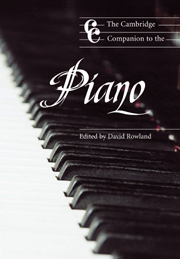Book contents
- Frontmatter
- Introduction
- Part one Pianos and pianists
- Part two Repertory
- 7 Repertory and canon
- 8 The music of the early pianists (to c.1830)
- 9 Piano music for concert hall and salon c.1830–1900
- 10 Nationalism
- 11 New horizons in the twentieth century
- 12 Ragtime, blues, jazz and popular music
- Glossary
- Notes
- Select bibliography
- Index
11 - New horizons in the twentieth century
from Part two - Repertory
Published online by Cambridge University Press: 28 September 2011
- Frontmatter
- Introduction
- Part one Pianos and pianists
- Part two Repertory
- 7 Repertory and canon
- 8 The music of the early pianists (to c.1830)
- 9 Piano music for concert hall and salon c.1830–1900
- 10 Nationalism
- 11 New horizons in the twentieth century
- 12 Ragtime, blues, jazz and popular music
- Glossary
- Notes
- Select bibliography
- Index
Summary
‘Take it for granted from the beginning that everything is possible on the piano, even when it seems impossible to you, or really is so.’ So wrote Busoni two years before the beginning of the twentieth century, prophesying the extraordinary explosion of compositional innovation which the new epoch would bring, and in which the development of the piano's technical and sonorous capabilities would play a crucial role. Yet in spite of the apparent desire on the part of several composers at the turn of the century to break firmly with tradition and cultivate an almost avant-garde approach to pianoforte composition, with hindsight it now seems abundantly clear that the exciting new developments in piano music in the early years of the century were firmly rooted in nineteenth-century precedent.
By 1916 the piano's impact on compositional developments had become sufficiently evident for E. J. Dent to publish an article entitled ‘The pianoforte and its influence on modern music’, in which he expressed the opinion that Liszt had been the ‘foundation of modern pianoforte-playing and pianoforte composition’ in spite of his various ‘shortcomings as a composer of real music’. The influence of Liszt's technical virtuosity and harmonic experimentation is to be seen clearly enough in Ravel's Jeux d'eau (1901), which owed much to the water-figurations of Liszt's Les jeux d'eau à la Villa d'Este (1877). The impressionistic application of virtuoso figurations to create atmospheric effects was adopted by Debussy in his piano music from the Estampes (1903) onwards, and Ravel's Gaspard de la nuit (1908) marked the apparent limits to which such technically demanding figurations could be stretched.
- Type
- Chapter
- Information
- The Cambridge Companion to the Piano , pp. 192 - 208Publisher: Cambridge University PressPrint publication year: 1998



